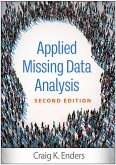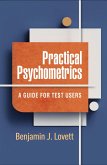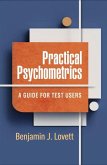David A. Kenny (United States University of Connecticut), Deborah A. Kashy (United States Michigan State University), William L. Cook (United States Maine Medical Center)
Dyadic Data Analysis
David A. Kenny (United States University of Connecticut), Deborah A. Kashy (United States Michigan State University), William L. Cook (United States Maine Medical Center)
Dyadic Data Analysis
- Broschiertes Buch
- Merkliste
- Auf die Merkliste
- Bewerten Bewerten
- Teilen
- Produkt teilen
- Produkterinnerung
- Produkterinnerung
This book offers state-of-the-art solutions by presenting methodological and data-analytic approaches for investigating processes that take place among dyads: couples, coworkers, parent and child, or doctor and patient, to name a few.
Andere Kunden interessierten sich auch für
![Applied Missing Data Analysis Applied Missing Data Analysis]() Craig K. Enders (United States Arizona State University)Applied Missing Data Analysis99,99 €
Craig K. Enders (United States Arizona State University)Applied Missing Data Analysis99,99 €![Five Ways of Doing Qualitative Analysis Five Ways of Doing Qualitative Analysis]() Frederick J. Wertz (United States Fordham University)Five Ways of Doing Qualitative Analysis78,99 €
Frederick J. Wertz (United States Fordham University)Five Ways of Doing Qualitative Analysis78,99 €![Practical Psychometrics Practical Psychometrics]() Benjamin J LovettPractical Psychometrics58,99 €
Benjamin J LovettPractical Psychometrics58,99 €![Practical Psychometrics Practical Psychometrics]() Benjamin J LovettPractical Psychometrics78,99 €
Benjamin J LovettPractical Psychometrics78,99 €![Evaluation Essentials Evaluation Essentials]() Marvin C. AlkinEvaluation Essentials66,99 €
Marvin C. AlkinEvaluation Essentials66,99 €![Mindfulness Mindfulness]() Christina Feldman (UKMindfulness52,99 €
Christina Feldman (UKMindfulness52,99 €![Applied Qualitative Research Design Applied Qualitative Research Design]() Margaret R. RollerApplied Qualitative Research Design77,99 €
Margaret R. RollerApplied Qualitative Research Design77,99 €-
-
-
This book offers state-of-the-art solutions by presenting methodological and data-analytic approaches for investigating processes that take place among dyads: couples, coworkers, parent and child, or doctor and patient, to name a few.
Hinweis: Dieser Artikel kann nur an eine deutsche Lieferadresse ausgeliefert werden.
Hinweis: Dieser Artikel kann nur an eine deutsche Lieferadresse ausgeliefert werden.
Produktdetails
- Produktdetails
- Verlag: Guilford Publications
- Seitenzahl: 458
- Erscheinungstermin: 29. Januar 2021
- Englisch
- Abmessung: 227mm x 150mm x 27mm
- Gewicht: 658g
- ISBN-13: 9781462546138
- ISBN-10: 1462546137
- Artikelnr.: 60371120
- Herstellerkennzeichnung
- Libri GmbH
- Europaallee 1
- 36244 Bad Hersfeld
- gpsr@libri.de
- Verlag: Guilford Publications
- Seitenzahl: 458
- Erscheinungstermin: 29. Januar 2021
- Englisch
- Abmessung: 227mm x 150mm x 27mm
- Gewicht: 658g
- ISBN-13: 9781462546138
- ISBN-10: 1462546137
- Artikelnr.: 60371120
- Herstellerkennzeichnung
- Libri GmbH
- Europaallee 1
- 36244 Bad Hersfeld
- gpsr@libri.de
David A. Kenny, PhD, is Board of Trustees Professor in the Department of Psychology at the University of Connecticut, and he has also taught at Harvard University and Arizona State University. He served as first quantitative associate editor of Psychological Bulletin. Dr. Kenny was awarded the Donald Campbell Award from the Society of Personality and Social Psychology. He is the author of five books and has written extensively in the areas of mediational analysis, interpersonal perception, and the analysis of social interaction data. Deborah A. Kashy, PhD, is Professor of Psychology at Michigan State University (MSU). She is currently senior associate editor of Personality and Social Psychology Bulletin and has also served as associate editor of Personal Relationships. In 2005 Dr. Kashy received the Alumni Outstanding Teaching Award from the College of Social Science at MSU. Her research interests include models of nonindependent data, interpersonal perception, close relationships, and effectiveness of educational technology. William L. Cook, PhD, is Associate Director of Psychiatry Research at Maine Medical Center and Spring Harbor Hospital, and Clinical Associate Professor of Psychiatry at the University of Vermont College of Medicine. Originally trained as a family therapist, he has taken a lead in the dissemination of methods of dyadic data analysis to the study of normal and disturbed family systems. Dr. Cook's contributions include the first application of the Social Relations Model to family data, the application of the Actor-Partner Interdependence Model to data from experimental trials of couple therapy, and the development of a method of standardized family assessment using the Social Relations Model.
1. Basic Definitions and Overview
Nonindependence
Basic Definitions
Data Organization
A Database of Dyadic Studies 2. The Measurement of Nonindependence
Interval Level of Measurement
Categorical Measures
Consequences of Ignoring Nonindependence
What Not to Do
Power Considerations 3. Analyzing Between
and Within
Dyads Independent Variables
Interval Outcome Measures and Categorical Independent Variables
Interval Outcome Measures and Interval Independent Variables
Categorical Outcome Variables 4. Using Multilevel Modeling to Study Dyads
Mixed
Model ANOVA
Multilevel
Model Equations
Multilevel Modeling with Maximum Likelihood
Adaptation of Multilevel Models to Dyadic Data 5. Using Structural Equation Modeling to Study Dyads
Steps in SEM
Confirmatory Factor Analysis
Path Analyses with Dyadic Data
SEM for Dyads with Indistinguishable Members 6. Tests of Correlational Structure and Differential Variance
Distinguishable Dyads
Indistinguishable Dyads 7. Analyzing Mixed Independent Variables: The Actor
Partner Interdependence Model
The Model
Conceptual Interpretation of Actor and Partner Effects
Estimation of the APIM: Indistinguishable Dyad Members
Estimation of the APIM: Distinguishable Dyads
Power and Effect Size Computation
Specification Error in the APIM 8. Social Relations Designs with Indistinguishable Members
The Basic Data Structures
Model
Details of an SRM Analysis
Model
Social Relations Analyses: An Example 9. Social Relations Designs with Roles
SRM Studies of Family Relationships
Design and Analysis of Studies
The Model
Application of the SRM with Roles Using Confirmatory Factor Analysis
The Four
Person Design
Illustration of the Four
Person Family Design
The Three
Person Design
Multiple Perspectives on Family Relationships
Means and Factor Score Estimation
Power and Sample Size 10. One
with
Many Designs
Design Issues
Measuring Nonindependence
The Meaning of Nonindependence in the One
with
Many Design
Univariate Analysis with Indistinguishable Partners
Univariate Estimation with Distinguishable Partners
The Reciprocal One
with
Many Design 11. Social Network Analysis
Definitions
The Representation of a Network
Network Measures
The p1 12. Dyadic Indexes
Item Measurement Issues
Measures of Profile Similarity
Mean and Variance of the Dyadic Index
Stereotype Accuracy
Differential Endorsement of the Stereotype
Pseudo
Couple Analysis
Idiographic versus Nomothetic Analysis
Illustration 13. Over
Time Analyses: Interval Outcomes
Cross
Lagged Regressions
Over
Time Standard APIM
Growth
Curve Analysis
Cross
Spectral Analysis
Nonlinear Dynamic Modeling 14. Over
Time Analyses: Dichotomous Outcomes
Sequential Analysis
Statistical Analysis of Sequential Data: Log
Linear Analysis
Statistical Analysis of Sequential Data: Multilevel Modeling
Event
History Analysis 15. Concluding Comments
Specialized Dyadic Models
Going Beyond the Dyad
Conceptual and Practical Issues
The Seven Deadly Sins of Dyadic Data Analysis
The Last Word
Nonindependence
Basic Definitions
Data Organization
A Database of Dyadic Studies 2. The Measurement of Nonindependence
Interval Level of Measurement
Categorical Measures
Consequences of Ignoring Nonindependence
What Not to Do
Power Considerations 3. Analyzing Between
and Within
Dyads Independent Variables
Interval Outcome Measures and Categorical Independent Variables
Interval Outcome Measures and Interval Independent Variables
Categorical Outcome Variables 4. Using Multilevel Modeling to Study Dyads
Mixed
Model ANOVA
Multilevel
Model Equations
Multilevel Modeling with Maximum Likelihood
Adaptation of Multilevel Models to Dyadic Data 5. Using Structural Equation Modeling to Study Dyads
Steps in SEM
Confirmatory Factor Analysis
Path Analyses with Dyadic Data
SEM for Dyads with Indistinguishable Members 6. Tests of Correlational Structure and Differential Variance
Distinguishable Dyads
Indistinguishable Dyads 7. Analyzing Mixed Independent Variables: The Actor
Partner Interdependence Model
The Model
Conceptual Interpretation of Actor and Partner Effects
Estimation of the APIM: Indistinguishable Dyad Members
Estimation of the APIM: Distinguishable Dyads
Power and Effect Size Computation
Specification Error in the APIM 8. Social Relations Designs with Indistinguishable Members
The Basic Data Structures
Model
Details of an SRM Analysis
Model
Social Relations Analyses: An Example 9. Social Relations Designs with Roles
SRM Studies of Family Relationships
Design and Analysis of Studies
The Model
Application of the SRM with Roles Using Confirmatory Factor Analysis
The Four
Person Design
Illustration of the Four
Person Family Design
The Three
Person Design
Multiple Perspectives on Family Relationships
Means and Factor Score Estimation
Power and Sample Size 10. One
with
Many Designs
Design Issues
Measuring Nonindependence
The Meaning of Nonindependence in the One
with
Many Design
Univariate Analysis with Indistinguishable Partners
Univariate Estimation with Distinguishable Partners
The Reciprocal One
with
Many Design 11. Social Network Analysis
Definitions
The Representation of a Network
Network Measures
The p1 12. Dyadic Indexes
Item Measurement Issues
Measures of Profile Similarity
Mean and Variance of the Dyadic Index
Stereotype Accuracy
Differential Endorsement of the Stereotype
Pseudo
Couple Analysis
Idiographic versus Nomothetic Analysis
Illustration 13. Over
Time Analyses: Interval Outcomes
Cross
Lagged Regressions
Over
Time Standard APIM
Growth
Curve Analysis
Cross
Spectral Analysis
Nonlinear Dynamic Modeling 14. Over
Time Analyses: Dichotomous Outcomes
Sequential Analysis
Statistical Analysis of Sequential Data: Log
Linear Analysis
Statistical Analysis of Sequential Data: Multilevel Modeling
Event
History Analysis 15. Concluding Comments
Specialized Dyadic Models
Going Beyond the Dyad
Conceptual and Practical Issues
The Seven Deadly Sins of Dyadic Data Analysis
The Last Word
1. Basic Definitions and Overview
Nonindependence
Basic Definitions
Data Organization
A Database of Dyadic Studies 2. The Measurement of Nonindependence
Interval Level of Measurement
Categorical Measures
Consequences of Ignoring Nonindependence
What Not to Do
Power Considerations 3. Analyzing Between
and Within
Dyads Independent Variables
Interval Outcome Measures and Categorical Independent Variables
Interval Outcome Measures and Interval Independent Variables
Categorical Outcome Variables 4. Using Multilevel Modeling to Study Dyads
Mixed
Model ANOVA
Multilevel
Model Equations
Multilevel Modeling with Maximum Likelihood
Adaptation of Multilevel Models to Dyadic Data 5. Using Structural Equation Modeling to Study Dyads
Steps in SEM
Confirmatory Factor Analysis
Path Analyses with Dyadic Data
SEM for Dyads with Indistinguishable Members 6. Tests of Correlational Structure and Differential Variance
Distinguishable Dyads
Indistinguishable Dyads 7. Analyzing Mixed Independent Variables: The Actor
Partner Interdependence Model
The Model
Conceptual Interpretation of Actor and Partner Effects
Estimation of the APIM: Indistinguishable Dyad Members
Estimation of the APIM: Distinguishable Dyads
Power and Effect Size Computation
Specification Error in the APIM 8. Social Relations Designs with Indistinguishable Members
The Basic Data Structures
Model
Details of an SRM Analysis
Model
Social Relations Analyses: An Example 9. Social Relations Designs with Roles
SRM Studies of Family Relationships
Design and Analysis of Studies
The Model
Application of the SRM with Roles Using Confirmatory Factor Analysis
The Four
Person Design
Illustration of the Four
Person Family Design
The Three
Person Design
Multiple Perspectives on Family Relationships
Means and Factor Score Estimation
Power and Sample Size 10. One
with
Many Designs
Design Issues
Measuring Nonindependence
The Meaning of Nonindependence in the One
with
Many Design
Univariate Analysis with Indistinguishable Partners
Univariate Estimation with Distinguishable Partners
The Reciprocal One
with
Many Design 11. Social Network Analysis
Definitions
The Representation of a Network
Network Measures
The p1 12. Dyadic Indexes
Item Measurement Issues
Measures of Profile Similarity
Mean and Variance of the Dyadic Index
Stereotype Accuracy
Differential Endorsement of the Stereotype
Pseudo
Couple Analysis
Idiographic versus Nomothetic Analysis
Illustration 13. Over
Time Analyses: Interval Outcomes
Cross
Lagged Regressions
Over
Time Standard APIM
Growth
Curve Analysis
Cross
Spectral Analysis
Nonlinear Dynamic Modeling 14. Over
Time Analyses: Dichotomous Outcomes
Sequential Analysis
Statistical Analysis of Sequential Data: Log
Linear Analysis
Statistical Analysis of Sequential Data: Multilevel Modeling
Event
History Analysis 15. Concluding Comments
Specialized Dyadic Models
Going Beyond the Dyad
Conceptual and Practical Issues
The Seven Deadly Sins of Dyadic Data Analysis
The Last Word
Nonindependence
Basic Definitions
Data Organization
A Database of Dyadic Studies 2. The Measurement of Nonindependence
Interval Level of Measurement
Categorical Measures
Consequences of Ignoring Nonindependence
What Not to Do
Power Considerations 3. Analyzing Between
and Within
Dyads Independent Variables
Interval Outcome Measures and Categorical Independent Variables
Interval Outcome Measures and Interval Independent Variables
Categorical Outcome Variables 4. Using Multilevel Modeling to Study Dyads
Mixed
Model ANOVA
Multilevel
Model Equations
Multilevel Modeling with Maximum Likelihood
Adaptation of Multilevel Models to Dyadic Data 5. Using Structural Equation Modeling to Study Dyads
Steps in SEM
Confirmatory Factor Analysis
Path Analyses with Dyadic Data
SEM for Dyads with Indistinguishable Members 6. Tests of Correlational Structure and Differential Variance
Distinguishable Dyads
Indistinguishable Dyads 7. Analyzing Mixed Independent Variables: The Actor
Partner Interdependence Model
The Model
Conceptual Interpretation of Actor and Partner Effects
Estimation of the APIM: Indistinguishable Dyad Members
Estimation of the APIM: Distinguishable Dyads
Power and Effect Size Computation
Specification Error in the APIM 8. Social Relations Designs with Indistinguishable Members
The Basic Data Structures
Model
Details of an SRM Analysis
Model
Social Relations Analyses: An Example 9. Social Relations Designs with Roles
SRM Studies of Family Relationships
Design and Analysis of Studies
The Model
Application of the SRM with Roles Using Confirmatory Factor Analysis
The Four
Person Design
Illustration of the Four
Person Family Design
The Three
Person Design
Multiple Perspectives on Family Relationships
Means and Factor Score Estimation
Power and Sample Size 10. One
with
Many Designs
Design Issues
Measuring Nonindependence
The Meaning of Nonindependence in the One
with
Many Design
Univariate Analysis with Indistinguishable Partners
Univariate Estimation with Distinguishable Partners
The Reciprocal One
with
Many Design 11. Social Network Analysis
Definitions
The Representation of a Network
Network Measures
The p1 12. Dyadic Indexes
Item Measurement Issues
Measures of Profile Similarity
Mean and Variance of the Dyadic Index
Stereotype Accuracy
Differential Endorsement of the Stereotype
Pseudo
Couple Analysis
Idiographic versus Nomothetic Analysis
Illustration 13. Over
Time Analyses: Interval Outcomes
Cross
Lagged Regressions
Over
Time Standard APIM
Growth
Curve Analysis
Cross
Spectral Analysis
Nonlinear Dynamic Modeling 14. Over
Time Analyses: Dichotomous Outcomes
Sequential Analysis
Statistical Analysis of Sequential Data: Log
Linear Analysis
Statistical Analysis of Sequential Data: Multilevel Modeling
Event
History Analysis 15. Concluding Comments
Specialized Dyadic Models
Going Beyond the Dyad
Conceptual and Practical Issues
The Seven Deadly Sins of Dyadic Data Analysis
The Last Word








